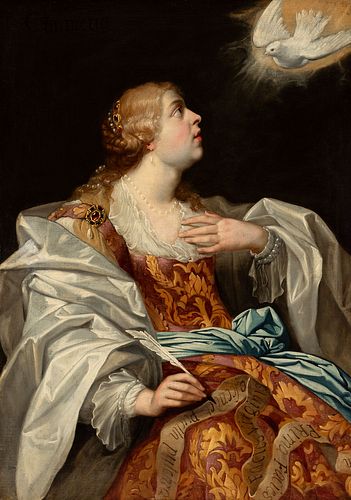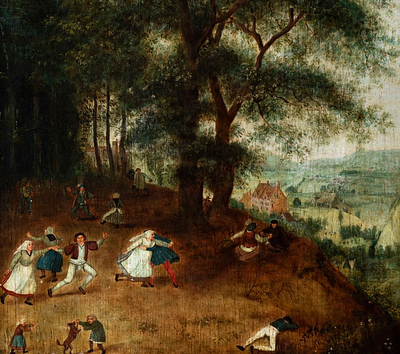ABRAHAM JANSSENS (Antwerp, Belgium, c. 1573 –1632). "The Sibyl Cimeria". Oil on canvas.
Lot 47
About Seller
Setdart Auction House
Carrer Aragó 346
Barcelona
Spain
Setdart Subastas was born in 2004 and is currently the first online art auction in Spain with solidity, prestige and reliability guaranteed by our more than 60,000 users. Setdart has a young, dynamic and enterprising team ready to successfully manage the purchase and sale of art works through custom...Read more
Estimate:
EUR€15,000 - EUR€16,000
$16,129.03 - $17,204.30
Absentee vs Live bid
Two ways to bid:
- Leave a max absentee bid and the platform will bid on your behalf up to your maximum bid during the live auction.
- Bid live during the auction and your bids will be submitted real-time to the auctioneer.
Bid Increments
| Price | Bid Increment |
|---|---|
| EUR€0 | EUR€10 |
| EUR€200 | EUR€25 |
| EUR€500 | EUR€50 |
| EUR€1,000 | EUR€100 |
| EUR€3,000 | EUR€200 |
| EUR€5,000 | EUR€500 |
| EUR€10,000 | EUR€1,000 |
| EUR€20,000 | EUR€2,000 |
| EUR€50,000 | EUR€5,000 |
About Auction
By Setdart Auction House
Jun 30, 2021
Set Reminder
2021-06-30 08:30:00
2021-06-30 08:30:00
America/New_York
Bidsquare
Bidsquare : Old Masters
https://www.bidsquare.com/auctions/setdart-auction-house/old-masters-7134
Setdart Auction House sofia@setdart.com
Setdart Auction House sofia@setdart.com
- Lot Description
ABRAHAM JANSSENS (Antwerp, Belgium, c. 1573 –1632). "The Sibyl Cimeria". Oil on canvas. 19th century framework. Provenance: Bob Jones University Collection. Measurements: 109 x 78 cm; 137 x 106 cm (frame). Abraham Janssens demonstrates his exquisite technical skill in this three-quarter portrait of the sibyl Cimeria. The sibyl is depicted in a seated position, gazing at a dove emanating from the darkness of the night. The treatment of the lavish fabrics, accentuating their tactile values through fine threads and gold brocade, as well as her exquisite necklace of white pearls, is particularly noteworthy. Janssens presents the sibyl as a beautiful and elegant young woman, her body slightly turned to avoid the rigidity of a strictly frontal composition. Formally, the figure is strongly illuminated and thus acquires a three-dimensional quality. The Sibyl of Cumae is considered to be the writer of the Sibylline books, a Roman collection of oracles. In ancient Greek mythology, the Sibyl was a prophetess, sometimes inspired by Apollo and whose powers had a divine origin. However, the number of these women soon increased from three to twelve, in all cases without knowing their names, but knowing them only by the name of the place where they lived. It was the Renaissance who recovered this figure, considering them heralds of Christ in the pagan tradition in order to give value to it and "Christianize" it. Of all the works in which they appear, the best known is probably Michelangelo's Sistine Chapel Vault, which shows the five most representative of the time (Eritrea, Persica, Libyan, Cumaean and Delphic). A Flemish Baroque painter specializing in figure subjects, Abraham Janssens trained as a disciple of Jan Snellinck, and is documented as an apprentice in the Guild of St. Luke in his native city in 1585. He later traveled to Italy between 1597 and 1602. The same year of his return he became a master member of the Antwerp Guild, and only five years later, in 1607, he became dean of that institution. In 1610 Janssens joined the Brotherhood of the Romanists, a society formed by humanists and artists who had made study trips to Rome. He had several disciples, among them his son Abraham Janssens II, Giovanni di Filippo del Campo, Gerard Seghers and Theodoor Rombouts, among others. His work mainly includes religious and mythological themes and allegorical scenes, although he also occasionally painted portraits. He began his career within a language still rooted in the mannerism of the sixteenth century, with compositions and figuresartificiosas and a palette of anti-classical tones, lightened by light. However, in his work "Scaldis and Antwerpia" of 1609, a clear evolution towards classical academic beauty, greater formal harmony and a more uniform palette can already be appreciated. This work also shows the influence of Caravaggio, mainly in the strong contrasts of light and shadow. However, after this masterpiece Janssens will lose his personality, like many of his Antwerp colleagues, due to the great influence of Rubens and his new language. In fact, until Rubens' return to Antwerp in 1608, Janssens was considered the most important painter of historical subjects, although in the last decades of his work he devoted himself mainly to religious commissions. Today, works by Abraham Janssens are held in the Metropolitan Museum in New York, the Art Institute of Chicago, the Kunsthistorisches Museum in Vienna, the National Galleries of Denmark, Slovenia, Romania and Poland, the Kremer Collection in The Hague and the Texas Museum of Fine Arts, among other public and private collections.
- Shipping Info
-
In-house shipping available. Please inquire at admin@setdart.com.
-
- Buyer's Premium



 EUR
EUR CAD
CAD AUD
AUD GBP
GBP MXN
MXN HKD
HKD CNY
CNY MYR
MYR SEK
SEK SGD
SGD CHF
CHF THB
THB
















